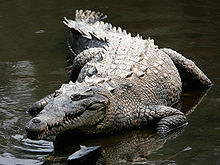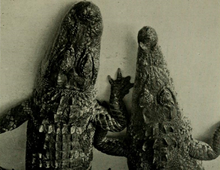Who is the American Crocodile?

Domain- Eukarya
Kingdom- Animalia
Phylum-
Chordata
Class- Reptilia
Order-
Crocodilia
Family- Crcodylidae
Genus- Crocodylus
Species-
Crocodylus acutus
Domain- Eukarya: Multicellular with membrane
bound organelles and lacks cell walls.
Kingdom- Animalia: Eukaryotic, multicellular,
heterotrophic, and motile at some stage in its life.
Phylum- Chordata: Possesses a notochord, dorsal
nerve chord, gill slits, thyroid gland, and a post anal tail at some
point in its lifetime.
Class- Reptilia: Cold blooded, amniotic egg
(contains extra membrane for protection and does not need water),
possesses lungs, and has epidermal scales.
Order- Crocodilia: Possess non-overlapping scales
made of keratin with studs of bony plates (scutes), front feet have
five separate toes, back feet have four webbed toes.
Family- Crocodylidae: Large aquatic reptiles that
live in freshwater and consist of th ree subfamilies.
ree subfamilies.
Genus- Crocodylus: Distinguishable narrow
snout and overall smaller size than the alligator relative, broken
down into 13 species.
Species- Crocodylus acutus: Crocodylus
acutus, which comes from the Latin words krokodelios (“pepple
worm”) and acutus (“pointed”), are noticeably lighter in color than
their alligator relatives. These organisms are also very
distinguishable in appearance from the alligator in the fact that
they have a significantly narrower head and overall appearance. Two
teeth that jut out noticeably from the lower jaw are also a key
physical characteristic that alligators do not possess. Also they
usually appear grayish green in color with a yellow underbelly and
have less armor in scales than other species of crocodiles. >>>>
 The phylogenetic tree on the left shows the place of each Domain,
supergroup and the sub-super group of Unikonta. If you start by
finding the red colored box at the very right, you will find the
animals, where Crocodylus acutus is located. As you work
your way back to the left following the red shaded boxes, you are
taking the path back through time as you follow the lineage of the
American crocodile on a grand scheme of phylogeny. As explained in
the reading above, Crocodylus acutus is a member of the
Animals which is a Sub-Super group of Unikonta. Continuing to the
left, the 5 major supergroups are listed, each of these is branched
off of the domain Eukarya. The domain Eukarya is comprised of
eukaryotic organisms which separates it from the other two domains.
Finally, the final stop on the tree is the common ancestor from
which all of life is believed to be derived from.
The phylogenetic tree on the left shows the place of each Domain,
supergroup and the sub-super group of Unikonta. If you start by
finding the red colored box at the very right, you will find the
animals, where Crocodylus acutus is located. As you work
your way back to the left following the red shaded boxes, you are
taking the path back through time as you follow the lineage of the
American crocodile on a grand scheme of phylogeny. As explained in
the reading above, Crocodylus acutus is a member of the
Animals which is a Sub-Super group of Unikonta. Continuing to the
left, the 5 major supergroups are listed, each of these is branched
off of the domain Eukarya. The domain Eukarya is comprised of
eukaryotic organisms which separates it from the other two domains.
Finally, the final stop on the tree is the common ancestor from
which all of life is believed to be derived from.
The second
phylogenetic tree that you see on the right is a hypothesis for the
Crocodylus genus based on mitochondrial DNA. Starting on
the left, the New World group is one of three groups that make of
the Crocodylus genus, the other tw o
being Africa and Asia-Australia. Moving forward from New World, we
see that this group is broken down into three other sub-groups due
to differences in the mitochondrial DNA of the different types of
crocodiles. Finally, as we get to the right side of the tree we see
that Crocodylus acutus is shaded red, signifying that you
have reached the end of your journey on finding where the American
crocodile came from. The closest relative using the mitochondrial
DNA is Crocodylus intermedius, which is the Orinoco
crocodile found in northern South America. Because this phylogeny is
based solely off of one characteristic, mitochondrial DNA, it is
considered to be monophyletic.
o
being Africa and Asia-Australia. Moving forward from New World, we
see that this group is broken down into three other sub-groups due
to differences in the mitochondrial DNA of the different types of
crocodiles. Finally, as we get to the right side of the tree we see
that Crocodylus acutus is shaded red, signifying that you
have reached the end of your journey on finding where the American
crocodile came from. The closest relative using the mitochondrial
DNA is Crocodylus intermedius, which is the Orinoco
crocodile found in northern South America. Because this phylogeny is
based solely off of one characteristic, mitochondrial DNA, it is
considered to be monophyletic.
Continue on and find out where these prehistoric beasts live in the present day. Habitat.
